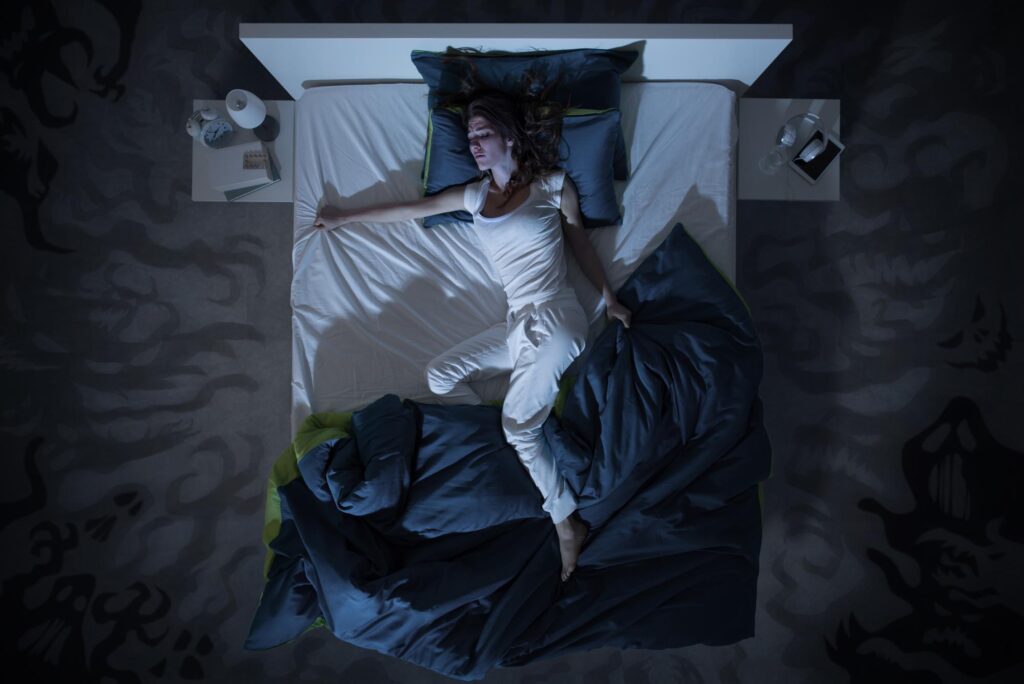Sleepless nights can feel endless when you’re going through tramadol withdrawal insomnia. As a prescription opioid medication commonly used to manage moderate to severe pain, tramadol helps millions of people—but stopping its use can bring unexpected challenges.
Many people find themselves tossing and turning at night after quitting tramadol, wondering, “Will I ever sleep normally again?” The good news is: yes, you will. While tramadol withdrawal insomnia is one of the most frustrating symptoms, it’s also temporary.
Think of it as your body’s way of readjusting. Your system is learning to function without the medication, and sleep disruption is a natural part of this healing process. You’re not alone in this experience—many others have walked this path before you and found their way back to restful nights.
Whether you’ve decided to quit tramadol or are considering it, understanding what lies ahead can make the journey easier. Let’s explore why sleep becomes challenging during withdrawal and discover practical ways to cope with these temporary sleep disturbances.
Understanding Tramadol Withdrawal Symptoms
When your body becomes accustomed to tramadol, it adapts to the drug’s presence by adjusting its natural chemical balance. Your brain reduces its production of natural pain-relieving chemicals, relying instead on the tramadol to maintain comfort and stability. Once you stop taking the medication, your body struggles to readjust, triggering withdrawal symptoms.
Withdrawal Timeline
The withdrawal timeline typically unfolds in distinct phases:
- First 12-24 hours: Early symptoms begin, including anxiety and drug cravings
- Days 2-3: Peak intensity of physical symptoms
- Days 4-7: Gradual reduction in physical discomfort
- Days 8-14: Emotional and psychological symptoms may persist
Common Withdrawal Symptoms
Common withdrawal symptoms include:
- Physical Effects
- Muscle aches and tremors
- Excessive sweating
- Runny nose and watery eyes
- Nausea and stomach cramps
- Rapid heartbeat
- Psychological Effects
- Intense anxiety
- Restlessness
- Difficulty concentrating
- Mood swings
- Sleep disturbances
Factors Influencing Severity
The severity of these symptoms varies based on factors like:
- Length of tramadol use
- Typical dosage
- Individual health conditions
- Method of discontinuation (sudden vs. gradual)
Many people describe tramadol withdrawal as a mix of traditional opioid withdrawal and antidepressant discontinuation symptoms, creating a unique and challenging experience that requires proper support and understanding.
Why Insomnia is a Common Symptom in Tramadol Withdrawal
Tramadol’s effect on sleep during withdrawal is due to its unique way of working. Unlike regular opioids, tramadol does two things: it activates opioid receptors and inhibits the reuptake of certain brain chemicals. This means it influences several neurotransmitters, including:
- Serotonin
- Norepinephrine
- Dopamine
These neurotransmitters are essential for controlling sleep patterns, mood, and energy levels. When you stop taking tramadol, your brain has difficulty readjusting its natural production of these chemicals, resulting in significant sleep disturbances.
The sleep problems experienced during tramadol withdrawal can be particularly severe compared to other substances. This increased insomnia occurs because tramadol withdrawal impacts:
- Your body’s natural pain management system
- Sleep-wake regulation centers in the brain
- Mechanisms that stabilize mood
- Natural melatonin production
Many individuals report that tramadol withdrawal insomnia feels different from typical sleeplessness. You may experience racing thoughts, physical restlessness, and an inability to stay asleep even when tired. This happens because your brain is working hard to restore its natural chemical balance while also coping with the absence of tramadol’s calming effects.
The combination of disrupted sleep patterns and changed brain chemistry makes insomnia one of the most difficult aspects of tramadol withdrawal to handle.
The Timeline for Sleep Normalization After Quitting Tramadol
Sleep patterns typically follow a predictable recovery timeline after stopping tramadol use:
Days 1-3: Initial Disruption
- Difficulty falling asleep begins
- Sleep may be fragmented and restless
- Total sleep time often reduced to 2-4 hours per night
Days 4-7: Peak Insomnia
- Peak insomnia symptoms
- Night sweats common
- Racing thoughts may interfere with sleep
- Brief periods of light sleep between wakeful periods
- Increased likelihood of developing tension headaches due to stress and lack of sleep
Days 8-14: Gradual Improvement
- Gradual improvement in sleep duration
- Easier time falling asleep
- Sleep quality remains variable
- Some nights better than others
Days 15-30: Normalization Begins
- Sleep patterns begin normalizing
- Increased periods of deep sleep
- Reduced nighttime restlessness
- Most people return to regular sleep cycles
Individual factors affecting recovery time:
- Length of tramadol use
- Daily dosage amount
- Overall health status
- Pre-existing sleep conditions
- Stress levels
- Support system
Many people notice significant sleep improvements within 2 weeks of stopping tramadol. Your body’s natural sleep-wake cycle will gradually reset itself as your brain chemistry rebalances. Some individuals may experience lingering sleep disturbances for several weeks, particularly those who used tramadol long-term or at higher doses.
Coping Strategies for Managing Tramadol Withdrawal Insomnia
Sleep might feel impossible during tramadol withdrawal, but several practical strategies can help you cope with tramadol withdrawal insomnia and find rest during this challenging time. Here are proven techniques to help manage withdrawal-related insomnia:
1. Create a Sleep-Friendly Environment
- Keep your bedroom cool, dark, and quiet
- Use blackout curtains or an eye mask
- Consider white noise machines to block disruptive sounds
- Invest in comfortable bedding and pillows
2. Establish a Calming Bedtime Routine
- Take a warm bath or shower before bed
- Practice gentle stretching or yoga
- Try deep breathing exercises or meditation
- Read a book or listen to soothing music
3. Maintain Healthy Sleep Habits
- Stick to a consistent sleep schedule
- Avoid screens 1-2 hours before bedtime
- Get exposure to natural sunlight during the day
- Exercise early in the day, not close to bedtime
4. Watch What You Consume
- Avoid caffeine after 2 PM
- Skip nicotine, especially in the evening
- Stay away from alcohol
- Don’t eat heavy meals close to bedtime
5. Natural Sleep Aids
- Try chamomile tea before bed
- Consider magnesium supplements
- Use lavender essential oils
- Practice progressive muscle relaxation
Remember that tossing and turning can increase anxiety. If you can’t sleep after 20 minutes, get up and do a quiet activity until you feel sleepy. These strategies work best when used consistently as part of your recovery routine.
Seeking Professional Help for Tramadol Withdrawal Insomnia
Tramadol withdrawal insomnia doesn’t have to be a solitary struggle. Medical detox programs offer structured, professional support that can make this challenging phase more manageable.
Advantages of Medical Detox
A medical detox setting provides several key advantages:
- 24/7 Medical Supervision: Healthcare professionals monitor your progress and adjust treatment plans as needed
- Safe Medication Management: Access to FDA-approved medications that can help regulate sleep patterns
- Personalized Treatment Plans: Tailored approaches based on your specific withdrawal symptoms and medical history
Specialized Therapies for Sleep Disturbances
Professional detox programs often incorporate specialized therapies to address sleep disturbances:
- Cognitive Behavioral Therapy for Insomnia (CBT-I)
- Light therapy to reset circadian rhythms
- Guided meditation sessions
- Sleep hygiene education
Role of Medical Professionals in Managing Sleep Aids
Medical professionals in these settings can prescribe appropriate sleep aids when necessary, helping you avoid the risks of self-medication. They’ll carefully monitor your dosage and response, adjusting treatment as your body progresses through withdrawal.
Benefits of a Structured Environment
The structured environment of a detox facility also provides:
- Regular health assessments
- Nutritional support
- Comfortable, quiet sleeping spaces
- Immediate medical attention if complications arise
Impact of Professional Support on Withdrawal Symptoms
Many people find that professional support significantly reduces the intensity of withdrawal symptoms, including sleep disturbances. A medical detox program creates a foundation for long-term recovery while ensuring your comfort and safety throughout the withdrawal process. These programs often include medication-assisted treatment which can further aid in managing withdrawal symptoms.
Exploring Residential Addiction Treatment Options
If you’re seeking a comprehensive approach to overcoming tramadol withdrawal, consider exploring residential addiction treatment options available in areas like Orange County.
Other Side Effects from Tramadol Withdrawal You Should Be Aware Of
While insomnia might feel like your biggest challenge right now, tramadol withdrawal can bring several other physical and emotional symptoms that need attention:
Physical Symptoms:
- Muscle aches and joint pain
- Sweating and chills
- Nausea and digestive issues
- Rapid heartbeat
- Runny nose and watery eyes
Emotional and Mental Effects:
- Intense anxiety or panic attacks
- Mood swings
- Irritability
- Depression
- Difficulty concentrating
These symptoms often appear together, creating a challenging experience that requires a comprehensive healing approach. Your body is working hard to readjust its chemical balance, and each symptom represents a part of this natural healing process.
A holistic treatment approach can help address these interconnected symptoms. This might include:
- Gentle exercise or yoga for physical discomfort
- Mindfulness practices for anxiety
- Nutritional support for digestive issues
- Therapeutic techniques for emotional symptoms
Remember – experiencing multiple withdrawal symptoms doesn’t mean you’re failing. It’s your body’s way of healing and returning to its natural state.
Conclusion
Breaking free from tramadol dependency takes courage, and the sleep challenges you’re facing are a testament to your strength in choosing recovery. While tramadol withdrawal insomnia can feel overwhelming, remember that your body is working hard to restore its natural sleep patterns.
You don’t have to navigate this journey alone. Professional support can make a significant difference in managing withdrawal symptoms and establishing healthy sleep habits. At SoCal Detox in Laguna Beach, our experienced team understands the unique challenges of tramadol withdrawal. We offer personalized care plans that combine medical expertise with holistic approaches to support your recovery journey.
Your path to restful sleep and renewed health starts here. Our peaceful coastal setting provides the perfect environment for healing, while our compassionate staff stands ready to guide you through each step of the detoxification process, utilizing our specialized detox services.
Ready to reclaim your sleep and your life? Contact SoCal Detox today through our contact page. Let us help you build a foundation for lasting recovery in our supportive, nurturing environment.
FAQs (Frequently Asked Questions)
How long does it take to sleep normally again after quitting Tramadol?
Most healthy adults may experience resolution of sleep disturbances within 1-2 weeks after quitting Tramadol, though individual variations can occur depending on personal health and withdrawal severity.
Why is insomnia a prominent symptom during Tramadol withdrawal?
Tramadol’s unique mechanism as a monoamine reuptake inhibitor disrupts normal neurotransmitter balance, leading to significant sleep disturbances. This effect makes insomnia more pronounced during opioid detoxification compared to other substances.
What are common symptoms experienced during Tramadol withdrawal besides insomnia?
Apart from insomnia, individuals may experience flu-like symptoms, body aches, nausea, anxiety, and other discomforts that collectively contribute to the challenging withdrawal phase.
What coping strategies can help manage insomnia caused by Tramadol withdrawal?
Effective strategies include practicing relaxation exercises, maintaining a consistent sleep schedule, avoiding stimulants like caffeine and nicotine, and creating a calming bedtime environment to promote better sleep quality.
When should someone consider seeking professional help for Tramadol withdrawal insomnia?
If insomnia becomes severe or unmanageable, seeking support from medical detox programs specializing in opioid dependence can provide personalized care and access to medications that alleviate sleep disturbances safely.
How does medical detox support recovery from Tramadol withdrawal insomnia?
Medical detox programs offer tailored treatment plans that address both physical and psychological symptoms of withdrawal, including insomnia. They ensure safe tapering of the drug and provide holistic support to improve overall recovery outcomes.

